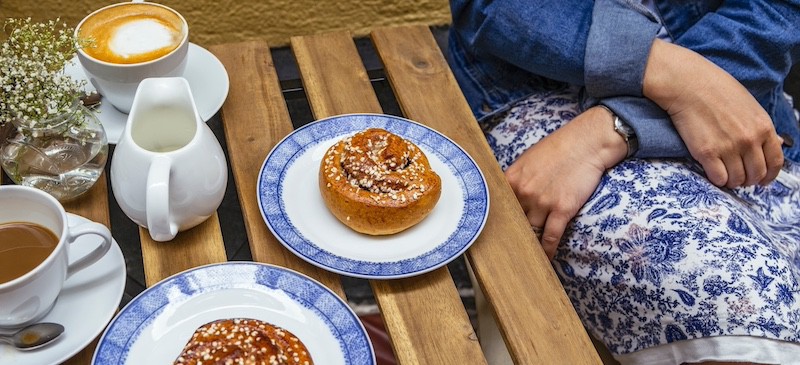Fika: The Swedish Coffee & Calm Ritual
- What Is Fika?
- Potential Benefits
- How to Fika Like a Swede

In the fast-paced and hectic world we inhabit, the pursuit of serene and connected moments has become an increasingly rare and precious commodity. Enter “fika,” the Swedish tradition that goes beyond merely grasping a cup of coffee; it transforms into a cultural institution centered around relaxation, social interaction, and the indulgence of life’s uncomplicated pleasures.
Dispense with the mundane coffee break. Fika (pronounced fee-kah) is a Swedish tradition that elevates the ordinary act of obtaining a cup of coffee to an artistic form. It transcends caffeine; it’s a social ritual, a moment of profound mindfulness, and a cornerstone of Swedish culture.
So, let’s embark on an exploration of the essence of fika, its distinctiveness from a mere coffee break, its potential benefits, and how you can embrace this enchanting ritual in your own existence.
What Is Fika?
Fika is not merely a word in Swedish; it represents a way of life.
Fundamentally, it involves taking a respite from work or daily routines to relish a cup of coffee or tea, frequently accompanied by a sweet treat or a light snack. It’s not simply about refueling. It’s a deeply cherished cultural practice ingrained within Swedish society, nurturing connections, relaxation, and mindfulness.
Fika, translating to “coffee” in Swedish, encompasses far more. It’s the act of taking a break, often accompanied by coffee and a sweet indulgence, to connect with friends, family, or colleagues. It can occur anywhere, from snug cafes to park benches, and at any point during the day.
Fika vs. Coffee Break
While fika might bear a resemblance to a typical coffee break, the two significantly diverge in purpose and ambiance. While a coffee break could be a rushed affair, fika is a deliberate pause, an opportunity to decelerate, savor the instant, and connect with others. It emphasizes quality over quantity, placing equal importance on the social aspect as on the refreshments themselves.
Although similar to a coffee break, fika delves deeper. It’s not solely about a rapid caffeine fix. It prioritizes social interaction, creating a dedicated space for conversation and connection.
It’s an opportunity to slow down, alleviate stress, and build stronger relationships.
Potential Benefits
Beyond the sheer pleasure of indulging in delectable treats, fika offers an array of potential benefits. It provides a mental interlude, enabling individuals to recharge and return to tasks with revitalized focus and creativity, similar to taking a mental health day. Moreover, the social aspect nurtures a sense of community and fortifies interpersonal relationships, contributing to overall well-being and happiness.
Here are some additional benefits of fika:
1. May Boost Productivity
Short breaks such as fika can actually enhance focus and concentration when you resume work. In fact, research indicates that taking breaks, even brief ones, may assist the brain in acquiring new skills.
2. Helps Strengthen Relationships
Fika nurtures a sense of community and belonging, leading to more robust bonds with colleagues and loved ones. Not only that, but several studies reveal that individuals who experience a sense of belonging tend to have superior health outcomes – or at least report feeling better and possessing stronger overall health.
3. Can Reduce Stress
Taking a mindful break permits you to de-stress and recharge, improving overall well-being. This can have substantial benefits for health considering stress plays a crucial role in nearly every aspect of the human body.
4. Promotes Mindfulness
Fika encourages you to savor the moment, appreciate simple pleasures, and disconnect from the daily hustle and bustle. Taken together, it can assist in teaching you how to be happy, such as by manipulating brain chemicals to enhance happiness, combating loneliness, and enhancing friendships.
How to Fika Like a Swede
Embracing fika in your own life is more straightforward than you might anticipate. To fika like a Swede:
- Place quality above speed.
- Opt for high-quality coffee or tea, and pair it with a delicious pastry or sandwich.
- Allocate dedicated time for fika, ideally in the morning and afternoon, to break up the day and cultivate a sense of routine.
- Most crucially, invite others to join you, whether it’s colleagues, friends, or family, and engage in meaningful conversations while relishing the moment.
Ready to embrace the fika lifestyle? Here’s how to do it correctly:
- The Food: Coffee is essential, but tea is also acceptable. Pair it with a classic Swedish pastry like a “kanelbulle” (cinnamon bun) or a “havrekaka” (oatmeal cookie).
- The Time: There’s no fixed time for fika. Swedes frequently enjoy it mid-morning, in the afternoon, or even during work hours.
- The Company: Fika is best savored with others! Invite colleagues, friends, or family to share a cup and conversation.
- The Ambiance: Discover a cozy spot – a cafe, park, or even your own home kitchen. The key is to create a relaxing atmosphere for conversation and connection, similar to how Danish people embrace hygge.
Conclusion
- Fika is far more than just a coffee break – it’s a philosophy. It serves as a reminder to slow down, connect with others, and savor the simple pleasures in life.
- Next time you have a craving for a coffee break, consider incorporating the spirit of fika. You might just uncover a new approach to relaxation, reconnection, and finding joy in the everyday niceties.
- In a world that often glorifies business and productivity, fika acts as a gentle reminder to slow down and appreciate life’s small joys. It’s a practice that transcends borders, offering a universal prescription for connection, relaxation, and mindfulness.
- So, the next time you feel overwhelmed or in need of a boost, why not take a cue from the Swedes and indulge in a fika? After all, there’s no sweeter way to nourish both the body and the soul.





